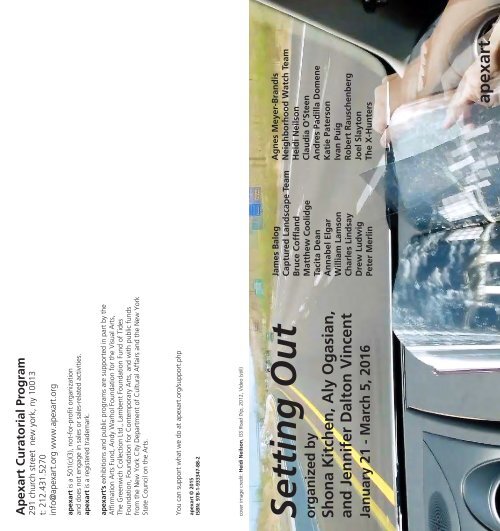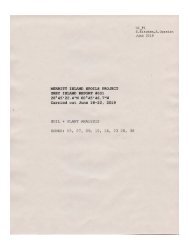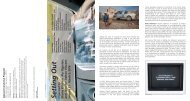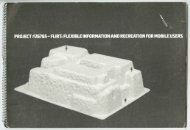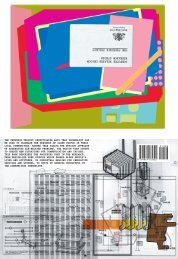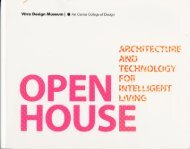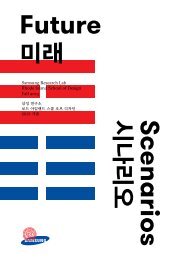Create successful ePaper yourself
Turn your PDF publications into a flip-book with our unique Google optimized e-Paper software.
Apexart Curatorial Program<br />
291 church street new york, ny 10013<br />
t: 212.431.5270<br />
info@apexart.org www.apexart.org<br />
apexart is a 501(c)(3), not-for-profit organization<br />
and does not engage in sales or sales-related activities.<br />
apexart is a registered trademark.<br />
apexart’s exhibitions and public programs are supported in part by <strong>the</strong><br />
Affirmation Arts Fund, Andy Warhol Foundation for <strong>the</strong> Visual Arts,<br />
The Greenwich Collection Ltd., Lambent Foundation Fund of Tides<br />
Foundation, Foundation for Contemporary Arts, and with public funds<br />
from <strong>the</strong> New York City Department of Cultural Affairs and <strong>the</strong> New York<br />
State Council on <strong>the</strong> Arts.<br />
You can support what we do at apexart.org/support.php<br />
apexart © 2015<br />
ISBN: 978-1-933347-88-2<br />
cover image credit: Heidi Neilson, ISS Road Trip, 2012, Video (still)<br />
Agnes Meyer-Brandis<br />
Neighborhood Watch Team<br />
Heidi Neilson<br />
Claudia O’Steen<br />
Andres Padilla Domene<br />
Katie Paterson<br />
Ivan Puig<br />
Robert Rauschenberg<br />
Joel Slayton<br />
The X-Hunters<br />
James Balog<br />
Captured Landscape Team<br />
Bruce Coffland<br />
Mat<strong>the</strong>w Coolidge<br />
Tacita Dean<br />
Annabel Elgar<br />
William Lamson<br />
Charles Lindsay<br />
Drew Ludwig<br />
Peter Merlin<br />
Setting Out<br />
organized by<br />
Shona Kitchen, Aly Ogasian,<br />
and Jennifer Dalton Vincent<br />
January 21 - March 5, 2016<br />
apexart<br />
Ivan Puig and Andrés Padilla Domene, SEFT-1, 2006-2011, Prints, 27 x 14 in<br />
Setting Out seeks to untangle <strong>the</strong> terms that motivate and<br />
define contemporary expeditions. It holds in one hand <strong>the</strong><br />
historical legacy of science, art, and society and <strong>the</strong>ir pursuit<br />
of all knowable and natural frontiers. It holds technology in<br />
its o<strong>the</strong>r hand and its connivance with human curiosity to see<br />
beyond each horizon. Toge<strong>the</strong>r <strong>the</strong>se fields create an image of<br />
<strong>the</strong> edge of human understanding.<br />
As curators, we set out on an exploration for work that<br />
represents <strong>the</strong> ethos and praxis of expeditions. The works we<br />
found demonstrate a recurrent set of practices and sentiments<br />
that circumscribe exploration’s essence. It didn’t matter if <strong>the</strong><br />
explorer was an artist or scientist, or if <strong>the</strong> subject was cellular<br />
or celestial. The human preoccupation with <strong>the</strong> frontier - where<br />
<strong>the</strong> knowable bleeds into <strong>the</strong> unknowable - holds steady at all<br />
scales. As such, we found that to explore entails <strong>the</strong> desire to<br />
search as well as <strong>the</strong> impulse to share.<br />
The works included in Setting Out all meet on this field of<br />
desire and dissemination. The language, methodologies, and<br />
influences that inform each are fluid. The explorer is at once a<br />
scientist-artist who creates <strong>the</strong> ground for <strong>the</strong>ir expedition as<br />
<strong>the</strong>ir process of exploration unfolds. In <strong>the</strong>ir hands, technology<br />
expresses a DIY plasticity, bending and twisting so that new<br />
images may be transmitted back.<br />
In 1962, British science writer and futurist Arthur C. Clarke<br />
envisioned a world forever shrunk by a vast net of communications<br />
satellites. According to Clarke, <strong>the</strong> implementation of <strong>the</strong>se<br />
satellites would collapse distance and time and enable mankind<br />
“to move almost instantaneously to any part of <strong>the</strong> world.”<br />
Abiding Clarke’s prescient vision, <strong>the</strong> launch of <strong>the</strong> first<br />
communications satellite ushered in an era of rapid technological<br />
innovation. In this new epoch, technology has extended<br />
human perception beyond <strong>the</strong> constraints of <strong>the</strong> human body.<br />
This promotes a culture of remote viewing, which paradoxically<br />
creates a greater distance between <strong>the</strong> viewer and <strong>the</strong> subjects<br />
or landscapes being viewed. These images deliver a disembodied<br />
understanding of <strong>the</strong> subjects <strong>the</strong>y depict. As such, today’s<br />
world of places and materials has transformed into a world of<br />
representations and information. As inhabitants of this new world,<br />
we access images of our horizons in increasing detail yet do not<br />
clearly perceive <strong>the</strong> shaky ground beneath our feet.<br />
Katie Paterson’s Ancient Darkness TV responds to today’s<br />
networked reality and reproduces an incomprehensible image<br />
of cosmic time and space. Working with astronomers from <strong>the</strong><br />
Mauna Kea Volcano telescope, Paterson’s Ancient Darkness TV<br />
records a transmission of ‘ancient darkness’ and broadcasts it on<br />
New York television station MNN. The work reveals darkness from<br />
<strong>the</strong> fur<strong>the</strong>st point of <strong>the</strong> observed universe - 13.2 billion years ago<br />
- shortly after <strong>the</strong> Big Bang and before Earth existed, when stars,<br />
galaxies, and <strong>the</strong> first light began to form.<br />
Like many of <strong>the</strong> artists in Setting Out, Paterson’s work points<br />
to how remote viewing technologies are inherently unable to<br />
transmit a sense of <strong>the</strong> space <strong>the</strong>y depict. Her work illuminates<br />
how technological media makes possible <strong>the</strong> material projection<br />
of place and time, and simultaneously presents us with an image<br />
that’s decidedly unte<strong>the</strong>red to ei<strong>the</strong>r. The word “dark” is often<br />
used to suggest <strong>the</strong> presence of <strong>the</strong> unknown. As viewers, we are<br />
literally left in <strong>the</strong> dark, wondering how and if this image allows<br />
us to comprehend our position in <strong>the</strong> universe. Or, perhaps, it<br />
simply leaves us at <strong>the</strong> periphery, oscillating between observation<br />
and imagination.<br />
Katie Paterson, Ancient Darkness TV, 2010, TV broadcast, VHS transfer to DVD, 6:09 min
From <strong>the</strong>se remote frontiers, Setting Out transmits images and<br />
artifacts that question <strong>the</strong> human desire for conquest over space<br />
and time. This documentation is <strong>the</strong> output of <strong>the</strong> curiosity that<br />
propels <strong>the</strong> explorer’s work. It reveals <strong>the</strong> desire to collect and share<br />
evidence of celestial and terrestrial hinterlands. Curiosity dovetails<br />
<strong>the</strong> work of <strong>the</strong> artist and scientist. This process of coming toge<strong>the</strong>r<br />
yields productive frictions and results in <strong>the</strong> commingling of differing<br />
methodologies, efforts, and approaches.<br />
extensive and multi-modal work pinpoints more than 100 aircraft<br />
crashes throughout <strong>the</strong> American Southwest - at places such as<br />
Edwards Air Force Base and Area 51 - by piecing toge<strong>the</strong>r clues<br />
from interviews with pilots, Freedom of Information Act requests,<br />
and archival research. Their aerospace archeology grounds itself at<br />
<strong>the</strong> resting place of X-Planes, experimental military aircraft once<br />
used to test <strong>the</strong> limits of aviation technology, predominately for<br />
advancement of military purposes.<br />
James Balog, Extreme Ice Survey, 2007<br />
As with Paterson’s Ancient Darkness TV, Heidi Neilson’s work deals<br />
with time, distance, and communication technology. Neilson’s<br />
ISS Roadtrip combines stills from a video clip taken from <strong>the</strong><br />
International Space Station as it orbited <strong>the</strong> earth into a book<br />
meant to be viewed in a moving car. From <strong>the</strong> passenger seat,<br />
<strong>the</strong> reader turns each page of Neilson’s book and simultaneously<br />
registers <strong>the</strong> velocity of <strong>the</strong> car in motion.<br />
ISS Roadtrip inserts <strong>the</strong> remote landscape of space into everyday<br />
life and transposes <strong>the</strong> satellite onto <strong>the</strong> automobile. Yet, despite<br />
<strong>the</strong> car’s willful complicity, it fails to reproduce <strong>the</strong> experience<br />
of moving through celestial space. The terrestrial remains <strong>the</strong><br />
terrestrial, and instead, <strong>the</strong> reader suspends <strong>the</strong>ir sensation of<br />
reality so that <strong>the</strong>y may follow Neilson into an intergalactic fantasy.<br />
Like Paterson, Neilson makes tangible an image of some distant<br />
periphery to which our lives are intimately yoked and infinitely<br />
removed.<br />
Joel Slayton, The Antenna Project, 2015<br />
Agnes Meyer-Brandis’ Moon Goose Analogue is such a poeticscientific<br />
investigation. The video presents Meyer-Brandis’ quasiscientific<br />
experiment in which she raised, trained, and equipped a<br />
flock of geese to fly to <strong>the</strong> moon. Inspired by Francis Godwin’s 17th<br />
century science fiction piece, “The Man in <strong>the</strong> Moone,” Meyer-<br />
Brandis mixes scientific and artistic practice to develop tools and<br />
systems that mirror and mimic those used in astronautics. The result<br />
is a touching and humorous pseudo-documentary that chronicles<br />
<strong>the</strong> tensions that occur when scientific and artistic approaches are<br />
merged.<br />
While some projects in Setting Out travel outward, o<strong>the</strong>rs turn<br />
<strong>the</strong>ir gaze inward so that <strong>the</strong>y may interrogate social and military<br />
infrastructures. They offer an alternate view of familiar landscapes<br />
and highlight <strong>the</strong> presence of industries, economies, and cultural<br />
phenomenon typically hidden or obscured. They curiously inspect<br />
<strong>the</strong> world at hand and conduct investigative processes that, at<br />
times, seem absurd and humorous. Their work excavates microand<br />
macroscopic territories, exposes hidden histories, and brings<br />
forgotten knowledge to <strong>the</strong> fore.<br />
Merlin and Moore’s work takes up technology as both tool and<br />
artifact. They travel to sites <strong>the</strong>y presume an X-Plane has crashed<br />
and methodically line up photographs of <strong>the</strong> crash sites with <strong>the</strong><br />
horizon. In this way, <strong>the</strong>y locate distinct geographic features and<br />
establish <strong>the</strong> relative distance or location of crashed X-Planes.<br />
Their fieldwork reveals a constellation of forgotten sites across<br />
<strong>the</strong> American Southwest and highlights <strong>the</strong> existence of an active<br />
military presence within <strong>the</strong> desert landscape. In training <strong>the</strong>ir eyes<br />
downward, <strong>the</strong>y map <strong>the</strong> undocumented history of aeronautic<br />
folly and failure buried in <strong>the</strong> landscape around us. Their findings<br />
reveal <strong>the</strong> ramifications of experimental technologies that push<br />
against <strong>the</strong> limits of speed and altitude. Merlin and Moore traverse<br />
<strong>the</strong> landscape on a microscopic scale; <strong>the</strong> minuscule fragments<br />
<strong>the</strong>y piece toge<strong>the</strong>r locate <strong>the</strong> hidden connection between earth<br />
and sky.<br />
Similarly, Matt Coolidge’s Center for Land Use Interpretation<br />
(CLUI) produces public programs that take participants out into<br />
<strong>the</strong> urban, technological, and industrial landscapes of Sou<strong>the</strong>rn<br />
California. Coolidge’s public programs identify and travel to sites<br />
of cultural significance within pre-existing, everyday landscapes.<br />
CLUI’s public programs “microcosmically” tour <strong>the</strong> systems that<br />
support our everyday existence such industrial mills, electrical<br />
William Lamson, A Line Describing <strong>the</strong> Sun, 2010, 2-channel video<br />
plants, and aqueducts. Using <strong>the</strong> language and methodology of a<br />
museum, Coolidge draws our attention to sites and infrastructures<br />
that have always been present but perhaps never noticed or<br />
explored.<br />
Expeditions of yesteryear operated at geological and political<br />
frontiers. They, by definition, charged into some unclaimed horizon<br />
in search of knowledge, resources, and territory. Yet, <strong>the</strong> horizons<br />
towards which <strong>the</strong>y strove were elusive and illusory.<br />
Setting Out has found that <strong>the</strong> horizon towards which today’s<br />
explorers reach now resides within sociological and technological<br />
terrains. These terrains are often formed from <strong>the</strong> integration of<br />
remote viewing technologies into our cultural consciousness. To<br />
examine <strong>the</strong>se spaces, <strong>the</strong> work showcased in Setting Out dovetails<br />
at <strong>the</strong> inexhaustible curiosity and desire to translate all worlds into<br />
<strong>the</strong> language of human experience.<br />
Yet, this curiosity privileges sight at <strong>the</strong> expense of <strong>the</strong> o<strong>the</strong>r senses<br />
- and in so doing perpetuates a disembodied stance on <strong>the</strong> edge<br />
of human knowledge. The work of each featured artist-scientistexplorer<br />
tirelessly fails to capture and communicate <strong>the</strong> fullness<br />
of <strong>the</strong> frontier. Ra<strong>the</strong>r, this space is understood only through <strong>the</strong><br />
collusion of all human senses - wherein <strong>the</strong> eyes, ears, skin, and<br />
musculature take in <strong>the</strong>ir surroundings and feel <strong>the</strong> scale of this<br />
unknown site.<br />
Shona Kitchen, Aly Ogasian, and Jennifer Dalton Vincent © 2015<br />
Unsolicited Proposal Program 2015-16<br />
Agnes Meyer-Brandis, Moon Goose Colony, 2011 Videostill © VG-Bild Kunst, 2015<br />
This is clearly articulated in <strong>the</strong> work of <strong>the</strong> X-Hunters Aerospace<br />
Archaeology Team, Peter Merlin and Tony Moore. Their<br />
The X-Hunters, documentation from 1992 expedition
Exhibitions Fellowship Publications Events Support General<br />
Images for Setting Out<br />
organized by Shona Kitchen, Aly Ogasian, and Jennifer Dalton Vincent<br />
on view January 21 March 5, 2016 at apexart nyc<br />
back to exhibition page<br />
INSTALLATION IMAGES<br />
Annabel Elgar, Specimen found in <strong>the</strong> trophy cupboard<br />
of first Fristad fly fishing club, Sweden, 2014; Annabel<br />
Elgar, Moon dust stockpile, New Forest, England, 2014;<br />
Works by James Balog, Claudia O’Steen, Joel Slayton,<br />
Bruce Coffland, XHunters: Peter Merlin and Tony<br />
Moore<br />
Works by James Balog, Claudia O’Steen, Joel Slayton,<br />
Bruce Coffland, XHunters: Peter Merlin and Tony<br />
Moore<br />
William Lamson, A Line Describing <strong>the</strong> Sun, 2010; Ivan<br />
Puig and Andrés Padilla Domene, Burro en Marte |<br />
Donkey on Mars, 2013; Ivan Puig and Andrés Padilla<br />
Domene, SEFT1 en Marte | SEFT1 on Mars, Colección<br />
Geológica de Marte | Geological Collection from Mars,<br />
2013<br />
Agnes MeyerBrandis, Moon Goose Colony, 2015 Agnes MeyerBrandis, Moon Goose Colony, 2015, Coproduced<br />
by The Arts Catalyst and FACT, in cooperation<br />
with Pollinaria, HD video, 20:56 min; Annabel Elgar,<br />
Moon dust stockpile, New Forest, England, 2014<br />
Annabel Elgar, Specimen found in <strong>the</strong> trophy cupboard<br />
of first Fristad fly fishing club, Sweden, 2014; Annabel<br />
Elgar, Moon dust stockpile, New Forest, England, 2014;<br />
Heidi Neilson, ISS Road Trip, 2012<br />
Agnes MeyerBrandis, Moon Goose Colony, 2015;<br />
Annabel Elgar, Specimen found in <strong>the</strong> trophy cupboard<br />
of first Fristad fly fishing club, Sweden, 2014; Annabel<br />
Elgar, Moon dust stockpile, New Forest, England, 2014;<br />
Heidi Neilson, ISS Road Trip, 2012; Heidi Neilson, ISS<br />
on I17N, 2012; Katie Paterson, Ancient Darkness TV,<br />
2010><br />
Robert Rauschenberg, Local Means (Stoned Moon),<br />
1970; Drew Ludwig, Personal Item, 2015; Tacita Dean<br />
Teignmouth Electron, Cayman Brac, 1999<br />
Drew Ludwig, Personal Item, 2015
Shona Kitchen, Alyson Ogasian, Claudia O'Steen,<br />
Stephen Cooke, Vivian Charlesworth, Tim Wang, Yun<br />
Hong, Captured Landscape, 2015; Tacita Dean,<br />
Teignmouth Electron Cayman Brac, 1999; Tacita Dean,<br />
Teignmouth Electron, 1999<br />
Shona Kitchen, Alyson Ogasian, Claudia O'Steen,<br />
Stephen Cooke, Vivian Charlesworth, Tim Wang, Yun<br />
Hong, Captured Landscape, 2015<br />
Charles Lindsay, Portable Device for Unforeseen<br />
Circumstances, 2015<br />
Ben Hooker + Shona Kitchen, Andrew Nagata, Tim<br />
Durfee Neighborhood Watch, 2013<br />
Ben Hooker + Shona Kitchen, Andrew Nagata, Tim<br />
Durfee Neighborhood Watch, 2013; Peter Merlin and<br />
Tony Moore, XHunters, Lea<strong>the</strong>r Jacket, 1984 present<br />
Peter Merlin and Tony Moore, XHunters, Lea<strong>the</strong>r<br />
Jacket, 1984present<br />
Installation view from back of gallery Installation view from back of gallery<br />
Shona Kitchen, Alyson Ogasian, Claudia O'Steen,<br />
Stephen Cooke, Vivian Charlesworth, Tim Wang, Yun<br />
Hong, Captured Landscape, 2015<br />
Shona Kitchen, Alyson Ogasian, Claudia O'Steen,<br />
Stephen Cooke, Vivian Charlesworth, Tim Wang, Yun<br />
Hong, Captured Landscape, 2015<br />
Shona Kitchen, Alyson Ogasian, Claudia O'Steen,<br />
Stephen Cooke, Vivian Charlesworth, Tim Wang, Yun<br />
Hong, Captured Landscape, 2015<br />
Shona Kitchen, Alyson Ogasian, Claudia O'Steen,<br />
Stephen Cooke, Vivian Charlesworth, Tim Wang, Yun<br />
Hong, Captured Landscape, 2015 (detail)<br />
William Lamson, A Line Describing <strong>the</strong> Sun, 2010; Ivan<br />
Puig and Andrés Padilla Domene, Burro en Marte |<br />
Donkey on Mars, 2013<br />
Ivan Puig and Andrés Padilla Domene, Burro en Marte |<br />
Donkey on Mars, 2013; Ivan Puig and Andrés Padilla<br />
Domene, SEFT1 en Marte | SEFT1 on Mars, Colección<br />
Geológica de Marte | Geological Collection from Mars,<br />
2013; Center for Land Use Interpretation, Posters for<br />
event excursions, 19942015<br />
Ivan Puig and Andrés Padilla Domene, Burro en Marte |<br />
Donkey on Mars, 2013; Ivan Puig and Andrés Padilla<br />
Domene, SEFT1 en Marte | SEFT1 on Mars, Colección<br />
Geológica de Marte | Geological Collection from Mars,<br />
2013; Center for Land Use Interpretation, Posters for<br />
event excursions, 19942015
Peter Merlin and Tony Moore, XHunters Then and Now<br />
Photographs, 1984present; XHunters Aerospace<br />
Archaeology, The XHunters, documentation from 1992<br />
expedition<br />
Claudia O’Steen, Arc of Visibility, 2015; James Balog,<br />
Extreme Ice Survey, 2007<br />
Claudia O’Steen, Arc of Visibility, 2015; James Balog,<br />
Extreme Ice Survey, 2007<br />
Claudia O’Steen, Arc of Visibility, 2015; James Balog,<br />
Extreme Ice Survey, 2007; Bruce Coffland,<br />
ZEISS/NS001/MAS, 1994; Joel Slayton, The Antenna<br />
Project, 2015<br />
Bruce Coffland, ZEISS/NS001/MAS, 1994; Peter Merlin<br />
and Tony Moore, XHunters Then and Now<br />
Photographs, 1984present; XHunters Aerospace<br />
Archaeology, The XHunters, documentation from 1992<br />
expedition<br />
XHunters Aerospace Archaeology, The XHunters,<br />
documentation from 1992 expedition<br />
BROCHURE IMAGES<br />
James Balog, Extreme Ice Survey, 2007 James Balog, Extreme Ice Survey, 2007<br />
Center for Land Use Interpretation, poster for event<br />
excursions, 19942015<br />
Tacita Dean, Teignmouth Electron, 1999/2009, Color<br />
photograph, 26 3/4 x 35 in.; Courtesy of <strong>the</strong> artist and<br />
Marian Goodman Gallery, New York<br />
Annabel Elgar, Moon dust stockpile, New Forest,<br />
England, 2014<br />
Annabel Elgar, Specimen found in <strong>the</strong> trophy cupboard<br />
of Fristad fly fishing club, Sweden, 2014
William Lamson, A Line Describing <strong>the</strong> Sun, 2010, 2<br />
channel video<br />
William Lamson, A Line Describing <strong>the</strong> Sun, 2010, 2<br />
channel video<br />
William Lamson, A Line Describing <strong>the</strong> Sun, 2010<br />
Charles Lindsay, Portable Device for Unforeseen<br />
Circumstances, 2015<br />
Drew Ludwig, Personal Item, 2015, Rock, duct tape,<br />
briefcase handle<br />
Drew Ludwig, Personal Item, 2015, Rock, duct tape,<br />
briefcase handle<br />
Agnes MeyerBrandis, Moon Goose Colony, 2015 (c).<br />
Coproduced by The Arts Catalyst and FACT, in<br />
cooperation with Pollinaria (video still)<br />
Agnes MeyerBrandis, Moon Goose Colony, 2015 (c).<br />
Coproduced by The Arts Catalyst and FACT, in<br />
cooperation with Pollinaria (video still)<br />
Heidi Neilson, ISS Road Trip, 2012, Book, 7 x 10 in.<br />
Heidi Neilson, ISS Road Trip, 2012, Book, 7 x 10 in.<br />
(video still)<br />
Heidi Neilson, ISS Road Trip, 2012, Book, 7 x 10 in.<br />
(video still)<br />
Claudia O’Steen, Arc of Visibility, 2015, Video,<br />
binocular/projector stands, Yellowheart, cedar, glass,<br />
rocks collected over time from 41°29’40.72”N, 71°<br />
8’8.10”W, sandbags containing sand from same<br />
coordinates, video projections, stainless steel, glass<br />
reflectors, aluminum, mirrored plexi, compass level
Claudia O’Steen, Arc of Visibility, 2015, Video,<br />
binocular/projector stands, Yellowheart, cedar, glass,<br />
rocks collected over time from 41°29’40.72”N, 71°<br />
8’8.10”W, sandbags containing sand from same<br />
coordinates, video projections, stainless steel, glass<br />
reflectors, aluminum, mirrored plexi, compass level<br />
Katie Paterson, Ancient Darkness TV, 2010, TV<br />
broadcast, VHS transfer to DVD, 6:09 min.<br />
Katie Paterson, Ancient Darkness TV, 2010, TV<br />
broadcast, VHS transfer to DVD, 6:09 min.<br />
Ivan Puig and Andrés Padilla Domene, SEFT-1, 2006<br />
2011, 27 x 14 in. Prints and 16 in. diameter artifacts<br />
Ivan Puig and Andrés Padilla Domene, SEFT-1, 2006<br />
2011, 27 x 14 in. Prints and 16 in. diameter artifacts<br />
Ivan Puig and Andrés Padilla Domene, SEFT-1, 2006<br />
2011, 27 x 14 in. Prints and 16 in. diameter artifacts<br />
The XHunters, X15 crash site, 1992<br />
The XHunters, documentation from 1992 expedition The XHunters, F6F5K crash site debris, 1997<br />
291 church street new york, ny 10013 tusat 11am6pm 212.431.5270 support apexart
Exhibitions Fellowship Publications Events Support General<br />
Public Program<br />
Preparing for Outer Space: Astronaut<br />
Training and Menus for Mars<br />
Janna Kaplan and Heidi Neilson in<br />
conversation<br />
In conjunction with <strong>the</strong> exhibition<br />
Setting Out<br />
organized by Shona Kitchen, Aly Ogasian, and<br />
Jennifer Dalton Vincent<br />
Friday, February 26: 7 pm<br />
00:00 / 69:13<br />
download video (453 MB .mp4)<br />
Janna Kaplan and Heidi Neilson will each present on topics relating to human survival in outer space. Kaplan will draw from her experience as a<br />
Space Research Specialist to discuss <strong>the</strong> tasks and challenges of preparing astronauts for spaceflight, while Neilson will present her Menu for Mars<br />
Supper Club project, which envisions <strong>the</strong> future of cuisine on Mars.<br />
Setting Out explores how <strong>the</strong> nature of expeditions has evolved into <strong>the</strong> modern day. Incorporating <strong>the</strong> work of archaeologists, engineers, scientists,<br />
and artists exploring a variety of realms both geographical and beyond, <strong>the</strong> exhibition demonstrates that all <strong>the</strong>se expeditions share <strong>the</strong> same eager<br />
hunger to uncover <strong>the</strong> unknown.<br />
Janna Kaplan, M.S., is Lecturer in Psychology and Senior Research Associate at Brandeis University’s Graybiel Lab, specializing in Neuropsychology and Space<br />
Research. At Brandeis since 1983, she studies human adaptation to various conditions of space flight, such as zeroG, highG, artificial gravity environments, spatial<br />
orientation, and space motion sickness. Within <strong>the</strong> Graybiel Lab, Kaplan has developed a program initiating commercial and private payload and research of astronaut<br />
training, of which she is now Program Lead and Senior Scientist. The training protocol focuses on sensorimotor human factors of flight, such as space motion sickness,<br />
spatial disorientation, spatial illusions, and movement errors in changing gravitoinertial force environments. Kaplan serves on Faculty Advisory Councils of <strong>the</strong> Brandeis<br />
Genesis Institute for Russian Jewry, and of <strong>the</strong> HadassahBrandeis Institute for <strong>the</strong> Study of Jewish Women. She frequently lectures on <strong>the</strong> science of space exploration. Of<br />
special interest to her is <strong>the</strong> role of STEM curriculum (science, technology, engineering, math) in <strong>the</strong> empowerment and intellectual development of adolescent girls.<br />
Heidi Neilson is an artist addressing topics such as wea<strong>the</strong>r, fake snow, and <strong>the</strong> cultural landscape of outer space. Her work is often collaborative and publishingbased.<br />
She is a member of <strong>the</strong> ABC Artists’ Books Cooperative, cofounded SP Wea<strong>the</strong>r Station, and her work is included in over 60 museum and university collections. Born in<br />
Oregon, Heidi received a BA in biology from Reed College and an MFA in painting from Pratt Institute, and lives and works in New York.<br />
Please join us for this free and open to <strong>the</strong> public apexart event.<br />
apexart's exhibitions and and public programs are supported in part by <strong>the</strong> Affirmation Arts Fund, <strong>the</strong> Andy Warhol Foundation for <strong>the</strong> Visual Arts, Bloomberg Philanthropies,<br />
Edith C. Blum Foundation, Mary Duke Biddle Foundation, The Greenwich Collection Ltd., Lambent Foundation Fund of Tides Foundation, and with public funds from <strong>the</strong><br />
New York City Department of Cultural Affairs and <strong>the</strong> New York State Council on <strong>the</strong> Arts.<br />
291 church street new york, ny 10013 tusat 11am6pm 212.431.5270 support apexart
Exhibitions Fellowship Publications Events Support General<br />
Public Program<br />
In Conversation:<br />
Charles Lindsay and Bruce Coffland<br />
In conjunction with <strong>the</strong> exhibition<br />
Setting Out<br />
organized by Shona Kitchen, Aly Ogasian, and<br />
Jennifer Dalton Vincent<br />
Friday, January 29: 7 pm<br />
00:00 / 74:34<br />
download video (488 MB .mp4)<br />
Charles Lindsay and Bruce Coffland discuss <strong>the</strong>ir experience working at NASA Ames Moffett Field from <strong>the</strong>ir respective points of view of as an<br />
artistresearcher and a NASA Operations Manager (Earth Science Office).<br />
Setting Out explores how <strong>the</strong> nature of expeditions has evolved into <strong>the</strong> modern day. Incorporating <strong>the</strong> work of archaeologists, engineers, scientists,<br />
and artists exploring a variety of realms both geographical and beyond, <strong>the</strong> exhibition demonstrates that all <strong>the</strong>se expeditions share <strong>the</strong> same eager<br />
hunger to uncover <strong>the</strong> unknown.<br />
Charles Lindsay is a multidisciplinary artist interested in technology, ecosystems, semiotics, and esoteric forms of humor. Lindsay creates immersive environments, sound<br />
installations, sculptures built from salvaged aerospace and biotech equipment, videos, and photographs. He is <strong>the</strong> Director of <strong>the</strong> SETI Institute’s AIR Program. Educated<br />
as an exploration geologist, Lindsay is a Guggenheim Fellow, recipient of <strong>the</strong> Robert Rauschenberg Residency, artistinresidence at Imagine Science Films, and <strong>the</strong><br />
innovator behind OSA EARS – a project designed to deliver real time sound from one of <strong>the</strong> world’s most biologically diverse ecosystems to anyone anywhere with<br />
internet. Lindsay’s work has been profiled by WIRED, Mo<strong>the</strong>rboard, ARTonAIR.org, Viralnet, NPR, and CNN International.<br />
Bruce Coffland is <strong>the</strong> Operations Manager for <strong>the</strong> Airborne Sensor Facility (ASF) at NASA Ames Research Center in Moffett Field, CA. Bruce has worked at <strong>the</strong> Airborne<br />
Sensor Facility for 35 years, coordinating and managing airborne Earth resource imagery acquisitions for NASA Earth Science investigators, and also for federal and state<br />
agencies including <strong>the</strong> U.S. Forest Service; U.S. Geological Survey; Department of Energy; <strong>the</strong> State of California, and numerous universities. Coffland has a Masters<br />
degree in Geography from San Jose State University, with a minor studies emphasis in urban planning and photography.<br />
Please join us for this apexart event.<br />
apexart's exhibitions and and public programs are supported in part by <strong>the</strong> Affirmation Arts Fund, <strong>the</strong> Andy Warhol Foundation for <strong>the</strong> Visual Arts, Bloomberg Philanthropies,<br />
Edith C. Blum Foundation, Mary Duke Biddle Foundation, The Greenwich Collection Ltd., Lambent Foundation Fund of Tides Foundation, and with public funds from <strong>the</strong><br />
New York City Department of Cultural Affairs and <strong>the</strong> New York State Council on <strong>the</strong> Arts.<br />
apexart<br />
291 Church Street, NYC, 10013<br />
t. 212 431 5270<br />
www.apexart.org<br />
291 church street new york, ny 10013 tusat 11am6pm 212.431.5270 support apexart
apexart<br />
Setting Out<br />
organized by Shona Kitchen, Aly Ogasian,and Jennifer Dalton Vincent<br />
January 21 - March 5, 2016<br />
291 church st. nyc, ny<br />
10013 p: 212.431.5270<br />
info@apexart.org; www.apexart.org
apexart<br />
http://bedfordandbowery.com/2016/01/journey-through-<strong>the</strong>-blizzardto-see-this-expedition-exhibition/<br />
291 church st. nyc, ny<br />
10013 p: 212.431.5270<br />
info@apexart.org; www.apexart.org
apexart<br />
Setting Out<br />
organized by Shona Kitchen, Aly Ogasian,and Jennifer Dalton Vincent<br />
December 23, 2015 - February 21, 2016<br />
291 church st. nyc, ny<br />
10013 p: 212.431.5270<br />
info@apexart.org; www.apexart.org
apexart<br />
Setting Out<br />
organized by Shona Kitchen, Aly Ogasian,and Jennifer Dalton Vincent<br />
December 23, 2015 - February 21, 2016<br />
http://dailyserving.com/2016/02/setting-out-at-apexart/<br />
291 church st. nyc, ny<br />
10013 p: 212.431.5270<br />
info@apexart.org; www.apexart.org
apexart<br />
Setting Out<br />
organized by Shona Kitchen, Aly Ogasian, and Jennifer Dalton Vincent<br />
January 21 - March 5, 2016<br />
291 church st. nyc, ny<br />
10013 p: 212.431.5270<br />
info@apexart.org; www.apexart.org
apexart<br />
291 church st. nyc, ny<br />
10013 p: 212.431.5270<br />
info@apexart.org; www.apexart.org
apexart<br />
291 church st. nyc, ny<br />
10013 p: 212.431.5270<br />
info@apexart.org; www.apexart.org
apexart<br />
http://hyperallergic.com/272341/tracking-artists-expeditions-from-glacier-surveys-to-a-search-for-nixons-missing-moon-rocks/<br />
291 church st. nyc, ny<br />
10013 p: 212.431.5270<br />
info@apexart.org; www.apexart.org
FRESH ART<br />
INTERNATIONAL<br />
CONVERSATIONS ABOUT CREATIVITY IN THE 21ST CENTURY<br />
FRESH VUE: SETTING OUT AT APEXART<br />
February 18, 2016 · in Fresh VUE<br />
Our podcast features<br />
curator Cathy Byrd in<br />
conversation with more<br />
than 100 culture makers<br />
from around <strong>the</strong> world.<br />
Setting Out at apexart Explores Territories At The Edge Of<br />
Human Understanding<br />
SEARCH<br />
CLICK BELOW TO<br />
GET OUR SMART<br />
GUIDE:<br />
Setting Out<br />
Jan 21–Mar 5, 2016apexart, NYC<br />
Enter your email<br />
address to subscribe to<br />
this blog and receive<br />
notifications of new<br />
posts by email.<br />
Email<br />
This exhibition came to our attention through Agnes Meyer-<br />
Brandis, a Berlin-based artist whose creative experiments<br />
we’ve featured on Fresh Talk. Curators Shona Kitchen, Aly<br />
Ogasian, and Jennifer Dalton Vincent discovered <strong>the</strong> work of<br />
Meyer-Brandis while on <strong>the</strong>ir quest to find artists and projects<br />
SUBSCRIBE for updates<br />
exploring territories “at <strong>the</strong> edge of human understanding.” The<br />
twenty projects in <strong>the</strong> show reveal a shared preoccupation with
twenty projects in <strong>the</strong> show reveal a shared preoccupation with<br />
<strong>the</strong> idea of “frontier.” Toge<strong>the</strong>r, <strong>the</strong>y demonstrate how<br />
<strong>the</strong> desire to search is inseparable from <strong>the</strong> impulse to share.<br />
To experience o<strong>the</strong>r points of view on <strong>the</strong> subject, listen<br />
to Texas Tech students talk about <strong>the</strong> road trip <strong>the</strong>y took for <strong>the</strong><br />
course Land Art of <strong>the</strong> American West. Clicking through <strong>the</strong>se<br />
two Fresh VUE features may have you packing your tent and<br />
sleeping bags: Georgia State University student artists and <strong>the</strong>ir<br />
instructor document <strong>the</strong>ir adventure at Joshua Tree and we<br />
share images of our own drive across <strong>the</strong> American Southwest.<br />
Setting Out, Setting Out,<br />
installation view, 2016installation view, 2016<br />
Charles Lindsay,<br />
Portable Device for<br />
Unforeseen<br />
Circumstances, 2015<br />
Center for Land Use<br />
Interpretation, poster<br />
for event excursions,<br />
1994-2015<br />
Drew Ludwig,<br />
Personal Item, 2015<br />
Agnes Meyer-Brandis,<br />
Moon Goose Colony,<br />
video still, 2015 (c)
William Lamson, A<br />
Line Describing <strong>the</strong><br />
Sun, 2010<br />
Annabel Elgar, Moon<br />
dust stockpile, New<br />
Forest, England, 2014<br />
The X-Hunters, F6F-<br />
5K crash site debris,<br />
1997<br />
Ivan Puig and Andrés<br />
Padilla Domene,<br />
SEFT-1, 2006-2011<br />
Heidi Neilson, ISS Setting Out,<br />
Road Trip, book, 2012Installation view, 2016<br />
Share this:<br />
10<br />
More<br />
Tags: Agnes Meyer-Brandis, apexart, contemporary art, exhibition, expedition, nyc<br />
Leave a Reply<br />
Name *<br />
Email *<br />
Website<br />
Post Comment →<br />
Notify me of follow-up comments by email.<br />
Notify me of new posts by email.


